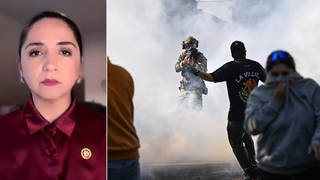
We look at a new report that reveals how Israel is using artificial intelligence to draw up targets in its military assault of Gaza. The report’s author, journalist Yuval Abraham, has found that the IDF’s increasing use of AI is partly a response to previous operations in Gaza when Israel quickly ran out of military targets, causing it to loosen its constraints on attacks that could kill civilians. In other words, the “civilian devastation that is happening right now in Gaza” is the result of a “war policy that has a very loose interpretation of what a military target is.” This targeting of private homes and residences to kill alleged combatants means that “when a child is killed in Gaza, it’s because somebody made a decision it was worth it.” It has turned the Israeli military into a “mass assassination factory,” with a “total disregard for Palestinian civil life,” continues Abraham, who also notes that, as an Israeli journalist, his reporting is still subject to military censors. We also discuss another recent report revealing that Israel may have received intelligence about Hamas’s planned attack more than a year in advance of October 7, but ignored it.
Transcript
AMY GOODMAN: Israel has resumed airstrikes on Gaza after a weeklong truce ended. The strikes have reportedly killed at least 70 Palestinians. Israel is dropping leaflets ordering Palestinians in Khan Younis, the largest city in southern Gaza, to head further south toward Rafah. Since the October 7th Hamas attack, the Israeli bombardment has killed over 15,000 Palestinians, including 6,100 children. The Office of the U.N. High Commissioner for Human Rights has described the resumption of attacks as “very troubling.”
RAVINA SHAMDASANI: The resumption of hostilities in Gaza is catastrophic. We urge all parties and states with influence over them to redouble efforts immediately to ensure a ceasefire on humanitarian and human rights grounds. Recent comments by Israeli political and military leaders indicating that they are planning to expand and intensify the military offensive are very troubling.
AMY GOODMAN: Talks are reportedly continuing for a new truce and the release of more captives. Israel says it believes Hamas still holds 137 hostages kidnapped during the October 7th attacks.
We turn now to look at a stunning new exposé on how Israel is using artificial intelligence to draw up targets and how Israel has loosened its constraints on attacks that could kill civilians. One former intelligence officer says Israel has developed a, quote, “mass assassination factory.”
In one case, sources said the Israeli military approved an assassination strike on a single Hamas commander despite knowing the strike could kill hundreds of Palestinian civilians. Another source told +972 Magazine, quote, “Nothing happens by accident. When a 3-year-old girl is killed in a home in Gaza, it’s because someone in the army decided it wasn’t a big deal for her to be killed — that it was a price worth paying in order to hit [another] target. … Everything is intentional. We know exactly how much collateral damage there is in every [home],” unquote.
+972 also reports the Israeli military knowingly attacked civilian targets, including apartment complexes, universities and banks, in an effort to exert, quote, “civil pressure” on Hamas.
We’re joined in Jerusalem by the Israeli investigative reporter Yuval Abraham. His latest report for +972 Magazine and Local Call is headlined “'A mass assassination factory': Inside Israel’s calculated bombing of Gaza.”
Yuval, thanks for joining us again from Jerusalem. If you can talk about who your sources are and what exactly they’re using — the Israeli military is using AI for? Explain this idea of a “mass assassination factory.”
YUVAL ABRAHAM: Sure, yeah. So, I’ll start by saying, Amy, that, you know, there are some things that I can say and other things that I cannot say. You know, we, as Israeli journalists, are subjected to the military censors, so everything that I have published had to be vetted by the military. And also my knowledge is partial.
So, I’ve spoken to seven Israeli intelligence officers, some of them current, some of them former intelligence officers. All of them took part in wars against Gaza, in bombing campaigns, whether right now or in 2021, 2022 and 2014. And the use of artificial intelligence is an increasing trend that the army is adopting to mark targets in Gaza.
And I think a good year to look at to understand its beginning with relation to Gaza is 2019, when the Chief of Staff Aviv Kochavi introduced this new division in the military called the Targets Division. And its idea was to bring together hundreds of soldiers and basically start to develop these AI algorithms and automated software to accelerate the target creation for strikes with life-and-death consequences in Gaza. And, you know, a source that actually took part in this division center said that they were being judged not by the quality of the targets that they were producing, but by the quantity, that the idea here was that if you want to create a certain shock effect, if you are fighting against a guerrilla group, like Hezbollah in Lebanon and/or Hamas in Gaza — this is the source saying — then — so, the source said that this shock effect is the way Israel views its war tactic against these organizations, and part of that is trying to accelerate the creation of targets.
Now, in 2014, which was the previous biggest Israeli assault on Gaza, according to sources that I’ve spoken with, the Israeli military ran out of targets after roughly three weeks. And that operation lasted for 50 days. And sources have described a sense that in previous operations, that the military just runs out of targets to bomb, and alongside that there is some political pressure or some need to continue the war, to create a victory image for the Israeli public, to work, you know, to apply more pressure. And I think this increasing use of artificial intelligence, this acceleration of target creation, in part, is a response to that problem, to running out of targets.
And what we know now from sources is that target production using these programs — one of them is called “The Gospel,” and according to sources, it does facilitate this mass assassination factory that I can get into in a moment. But the rate of creating the targets is now faster than the rate that Israel is able to bomb the targets. And in this Targets Division, according to the army’s sources, already 12,000 targets were created during this war in this Targets Division, using these artificial intelligence tools, which is too much — two times as many targets as were bombed in the entirety of the 2014 war, which lasted for 51 days.
AMY GOODMAN: Yuval Abraham is a journalist based in Jerusalem who writes for +972 Magazine and Local Call. He’s just written a piece called “'A mass assassination factory': Inside Israel’s calculated bombing of Gaza.” We’ll be back in 30 seconds.
[break]
AMY GOODMAN: Students at the Ramallah Friends School in the occupied West Bank singing a solidarity song for the children of Gaza with their teachers Safia Awad and Issa Jildeh. In just a moment, we’ll be speaking with Elizabeth Price, the mother of one of the three Palestinian college students in the United States who was shot in Burlington, Vermont, Saturday night. But right now we’re continuing with Yuval Abraham, journalist based in Jerusalem, who writes for +972 Magazine. His most recent piece”:https://www.972mag.com/mass-assassination-factory-israel-calculated-bombing-gaza/, “'A mass assassination factory.'” Yuval, explain what a power target is.
YUVAL ABRAHAM: Sure, yes. So, power targets is a concept that was developed, according to intelligence sources in the military, first in 2014. And the military defines power targets as residential high-rise buildings. So they have eight floors, 12 floors, 14 floors. And the official military’s claim is that in each of these buildings there is military target that merits, that legitimizes bombing down the entire building. However, according to three sources in Israeli intelligence that I’ve spoken with who have deep knowledge of this tactic, who have been involved with bombing power targets, they say that the idea of power targets is to purposely attack buildings that have all of these civilian apartments in them in order to put pressure on Palestinian civilian society in Gaza, which is then translated to pressure on Hamas, civilian pressure on Hamas. I’ve heard this term several times in my conversations with intelligence sources.
Now, in 2021, Amy, the Israeli military bombed the Al-Jalaa building in Gaza, which — you know, it caused an international uproar because this was a building that hosted the AP, AFP and Al Jazeera media outlets. It was one out of nine high-rises that were bombed in 2021. I have managed to confirm from sources within Israeli intelligence that this was, in fact, a power target. One source said that there was this idea that if we bomb the high-rises, it causes the civilians to feel like Hamas is not sovereign, like they have lost control. One source said that he felt this was a form of a terror tactic.
Now, very importantly, the sources that I’ve spoken with have dealt with these power targets before 2023, before the current Israeli assault in Gaza. So I know less about the specifics of power targets that are currently bombed; however, we do know from official army statements that Israel, during the first five days, so up until October 11th and October 12th, has bombed 1,329 power targets. The military says that half of the targets that were bombed were identified as power targets in the military.
Now, during these five days, we know, of course, that hundreds of children have been killed. We have managed to find indications of these buildings that were bombed without an evacuation protocol. And this is a very important point, because, according to sources that I’ve spoken with, in the past the internal protocol in the military was that you can only bomb power targets, which are high-rise buildings or governmental buildings inside neighborhoods, after you’ve evacuated all the families from the building. This was a principle that was in place in 2021, where they bombed nine high-rises, nine power targets. And no civilian Palestinians were killed, because they did put in place an evacuation protocol. They call, you know, the guard in the building. It’s quite horrific. You know, there is little missiles. But at the end of the day, the goal was to put pressure on civilians by destroying their apartments, from what I’ve heard from sources, and not by killing them.
Now, I don’t know — again, I haven’t spoken to sources that have bombed power targets in this operation, but there are clear indications that I am finding in Gaza — for example, the Al-Mohandessin Tower, which was bombed, on top of all the families inside of it, or Babel Tower or Al-Taj Tower — that they were bombed while the families were inside. And I think — I am assuming, since these are high-rises, and since the military has said that it bombed over a thousand power targets, that these were power targets. So this is a shift. I mean, the evidence suggests there is a shift here of not only striking targets that are primarily intended to cause civilian shock or to put civilian pressure on Hamas — again, according to intelligence sources — but, apparently, in some of the cases, the evidence suggests that such targets have also led to the killing of families.
AMY GOODMAN: I want to turn to U.S. Secretary of State Antony Blinken speaking Thursday at a news conference in Tel Aviv.
SECRETARY OF STATE ANTONY BLINKEN: Israel has the most sophisticated — one of the most sophisticated militaries in the world. It is capable of neutralizing the threat posed by Hamas while minimizing harm to innocent men, women and children. And it has an obligation to do so. … The way Israel defends itself matters. It’s imperative that Israel act in accordance with international humanitarian law and the laws of war.
AMY GOODMAN: So, Yuval Abraham, if you can respond to what Blinken is saying? You know, at the beginning, after the October 7th attack, President Biden said that the support for Israel was unconditional, they could do anything they wanted. Now, clearly, with massive pushback in the United States with protests of people all over the country and around the world, you have both Biden and Blinken stepping back and saying you have to protect civilians. One of your sources suggested that the scale of this attack, with an unprecedented number of civilian casualties in Gaza, has to do in part with the Israeli military’s wish to redeem itself after the catastrophic failures of October 7th. And now you have this big New York Times exposé that Israel clearly knew a year ago the blueprint for this attack. And there are other reports, in Haaretz and other places, that say — I think they were called — the women surveillance soldiers along the Gaza border, I think they’re called spotters, were repeatedly telling their supervisors in the last weeks, in the last months, “We see this escalation here. It looks like Hamas is about to attack.” And they would be told they’d be brought up on insubordination charges if they kept pushing this issue. Yuval?
YUVAL ABRAHAM: Yes, Amy. It’s very important for me to respond to Blinken’s statements. And I have three things that I really want to say, and I really want people to listen to them.
The first is that the very real war crimes that Hamas has committed, you know, killing people — some of them I knew — massacring people, do not justify Israeli war crimes in Gaza that are being committed. That’s number one.
Number two, this idea that the military is doing whatever it can to keep civilians in Gaza safe or that it is using its technology to not harm civilians in Gaza is false. It’s not true. And I know this not only from looking at the catastrophic killing of so many civilians in Gaza, but also by speaking to intelligence sources who have told me that now all of the previous restrictions, that were already permissive, into harming civilians have been dramatically loosened. For example, one source spoke about how you get sort of this approximation of where a target is, and it’s not pinpointed. And yet soldiers will still strike it, knowingly killing families and civilians, to save time, to save time in getting a more accurate pinpointing of the target. It’s very important that people understand that — and this according to five sources that I’ve spoken with in Israeli intelligence — in all of the target files that Israel is bombing right now, the amount of civilians that are likely to be killed is written down. So, again, it’s not a mistake. As you’ve quoted in the beginning of the piece, in the beginning of the narration, Amy, when a child is killed in Gaza, it’s because somebody made a decision that this killing was worth it to hit another target. And there are internal regulations that the army has created that regulate this. And so it’s very clear to me that after October 7th there is a total disregard for Palestinian civilian life, even when hitting targets that are either not distinctly military in nature.
The third and final thing — and this goes back to the idea of a mass assassination factory — is that there is a systematic policy, according to sources, of targeting private residential homes of Hamas or jihadi operatives when they are in these private homes, when they are in these buildings or private residences. And just so you understand, I mean, what this means is that the military is knowingly dropping a bomb, that weighs a ton, or often more, on a residential building in order to assassinate one person, knowingly killing that person’s family and neighbors in the process, when, according to sources, in the vast majority of cases, these buildings are not places where there is military activity that is being conducted. It is an assassination against somebody who is in Hamas or Jihad’s military brigades, but they are not in a military place. One source who was particularly critical of this policy said that he thought it was like if Israel would bomb — sorry, if a Palestinian militant group would bomb the homes of Israelis, not when they are wearing their army uniform, but when they are going back home in the weekend, and essentially assassinating them through the bodies of their families or their neighbors, and then saying that they use those families as human shields.
Now, I think that we’ve talked about these power targets, and we’ve talked about these assassination targets, and, of course, there are many different types of targets that could be considered, under international law, more legitimate — for example, militant cells, for example, ammo warehouses, for example, you know, rocket launcher pits. And I think that to look at the civilian devastation that is happening right now in Gaza, you have to understand that it’s a consequence of a particular Israeli war policy. It is a war policy that has a very loose interpretation of what a military target is, also attacking people in civilian spaces. It is a war policy that centers on deterrents and hitting these power targets that are intended to place civilian pressure on Hamas. And it is a war policy that is increasingly being helped by the use of big data, automation software and AI. And again, I don’t know everything; I’ve only spoken to several sources. But my evidence suggests that many, many of the civilians who are being killed in Gaza are being killed as a result of these policies, that I do not think are justifiable policies. International law experts would call them war crimes. And that’s why I don’t think that what Blinken is saying is true, honestly.
AMY GOODMAN: And we’re going to talk more about war crimes later in the program. Yuval Abraham, I want to thank you for being with us, Israeli Jewish journalist based in Jerusalem, who writes for +972 Magazine and Local Call. We’ll link to your new piece, “'A mass assassination factory': Inside Israel’s calculated bombing of Gaza.”












Media Options